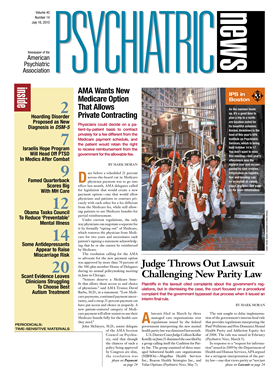Summer has begun—school is out, and youngsters are heading off to camp while parents are lowering the thermostat and planning family vacations. As the pace of life slows for many, that's not the case for APA; we have a very full and busy summer scheduled. Our calendar of summer events includes the yearlong preparation for our annual meeting (May 14 to 18, 2011, in Honolulu), as well as the final preparations for an outstanding Institute on Psychiatric Services in Boston October 14 to 17 (see
Sessions Focus on Restoring ‘Lost Art of Leadership’). One of the most important summer activities of APA's calendar—the yearly budget preparation—revs up in June and peaks in early fall.
As many of you know, I spent four years as APA treasurer. Until that time, I didn't have a good understanding of the APA budget process and how our annual budget related to our district branches (DBs) and Areas. So I thought it might be helpful to give you a brief overview, especially given today's challenging economic environment and the changes in APA policy regarding the pharmaceutical industry.
The Finance and Budget Committee has responsibility for developing a budget for the next calendar year to be presented to the Board of Trustees for final action. The committee, chaired by Frank Brown, M.D., includes officers of the Board and Assembly and psychiatrists with expertise in financial issues. During the committee's meeting in June, members reviewed the overall financial status of the Association, including revenue and expenses in 2009 and projections for 2010, and began the process of developing budget options for 2011. Since that meeting, APA staff have prepared departmental and program budgets for internal review, and these will form a basis for the committee's October meeting.
APA's annual revenue in 2009 was approximately $54 million—a drop of $10 million from 2008. This revenue comes from three major sources: membership dues, publications, and CME—primarily our annual meetings. Publications and meetings generate considerable expenses (the two together account for almost three-quarters of our budgeted expense), leaving a net income from revenue-producing activities of about $11 million, mainly from dues.
So where does this $11 million go? Twenty-seven percent is allocated to governance (Board, Assembly, components, and support for our district branches and state associations); 37 percent goes to our advocacy work, which includes the departments of Government Relations, Communications and Public Affairs, and Healthcare Systems and Financing; and approximately 32 percent goes to support education and research (but not DSM), including Minority and National Affairs. We spend about 4 percent of our discretionary budget (about $500,000) on public education work by the American Psychiatric Foundation. Overall, our expense budget runs about $3 million to $4 million less than our revenues, and we have put about that amount into our reserves and used some of the surplus to fund DSM-5 expenses.
There are several other important facts. First, from 2008 to 2009, APA experienced a drop of about $3.5 million in advertising revenue in our publications. In addition, during that time, we experienced a drop of $2.6 million in CME support from the pharmaceutical industry. These revenue losses are projected to continue.
APA has worked hard to hold national dues rates steady with minimal increases, but your total dues bill also includes local charges set by Area Councils and DBs.
Why is this information important? For as long as I have belonged to APA, I have noted that there are many resources at our national headquarters that never seem to reach our membership. For the most part, our DBs have few staff and rely heavily on the dedicated volunteer efforts of local psychiatrists. The DB executives do a terrific job with limited resources. We need to find a way to leverage local initiatives more effectively and take better advantage of centralized expertise.
As we move away from our financial dependence on big pharma, efforts to provide resources for state advocacy efforts, local educational programs, mentorship for young psychiatrists, media outreach, and so on will be challenged. I welcome your thoughts, particularly with regard to how we can help our national organization reach more of you where you live and work. Also, what are your thoughts regarding finding new revenues to offset the losses from advertising and the pharmaceutical industry? Should we raise dues? Should we try to centralize our functions? Let me know. I invite you to contact me at
[email protected].
As part of our commitment to transparency, more specific financial information can be found in the Members Corners of the APA Web site at <
www.psych.org>.


